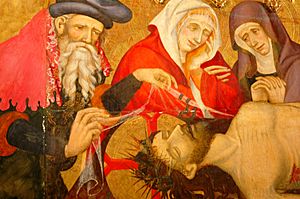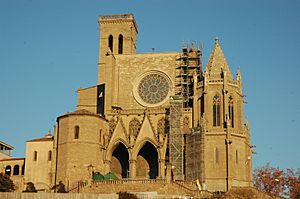Santa Maria, Manresa facts for kids
The Collegiate Basilica of Santa Maria, often called La Seu, is a very old and beautiful church. It is located in Manresa, a city in Catalonia, northern Spain. This church shows off two main styles of building: Romanesque and Gothic.
Contents
History of La Seu
The church of Santa Maria was first mentioned in records way back in the year 890. This means it has been around for a very long time!
Early Challenges and Rebuilding
In 999, the church and the entire city were badly damaged. This happened when troops led by a leader named Al-Mansur attacked.
Just one year later, in 1000, important people decided to fix the church. These included Count Ramon Berenguer I of Barcelona and his mother Ermesinde. They also worked with Oliba, who was a bishop. They all wanted to make the church new again.
Building the Gothic Church
Today, only small parts of the very first Romanesque church remain. You can still see some old columns from the 11th century. These columns have cool designs of plants and shapes. There's also a doorway from the 12th century.
In the 1300s, Manresa grew a lot. Because of this, people decided to build a much bigger, new Gothic church. This new church was built right on top of the older one.
Construction started in 1322. The main architect was Berenguer de Montagut. He had also worked on another famous church, Santa Maria del Mar, in Barcelona. The first stone was placed in 1328. However, building such a big church took a very long time. Work continued into the 1400s and even later.
Later Additions and Changes
Over the years, more parts were added to the church. The crypt, which is an underground room, was built in 1578. The Chapel of the Holiest was added in 1657.
The tall, square bell tower was finished in 1592. The beautiful Baroque cloister, which is a covered walkway, was built in the early 1700s.
The main front of the church and the baptisteries are much newer. They were built between 1915 and 1934. These parts were designed by Alexandre Soler i March. His ideas came from an earlier concept by the famous architect Antoni Gaudí.
Inside La Seu
The church has a large main area called a nave. On each side, there are two narrower aisles. These areas are separated by eighteen tall, eight-sided pillars. The tops of these pillars have carvings of plants. The church does not have a transept, which is a part that usually crosses the main body of a church.
The inside of the church is not overly decorated. However, it has large, colorful windows that let in beautiful light.
Important Artworks

La Seu is home to several important artworks. Many of these are altarpieces. An altarpiece is a piece of art placed behind the altar in a church.
Some of the famous altarpieces include:
- St. Mark: This was painted by Arnau Bassa in 1346.
- Holy Spirit: This altarpiece was created by Pere Serra in 1394. It is thought to be one of the best examples of Catalan painting from the 1300s.
- St. Michael and St. Nicholas: This work was painted by Jaume Cabrera in 1406.
- Holy Trinity: This is a later work by Gabriel Guàrdia, finished in 1501.
There is also a painting by Lluís Borrassà from 1411.
See also
 In Spanish: Colegiata Basílica de Santa María de la Aurora (Manresa) para niños
In Spanish: Colegiata Basílica de Santa María de la Aurora (Manresa) para niños



